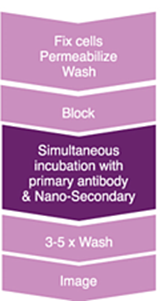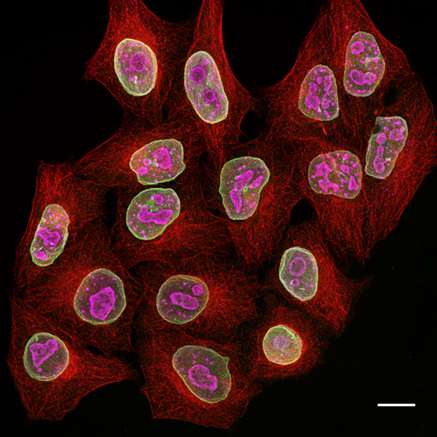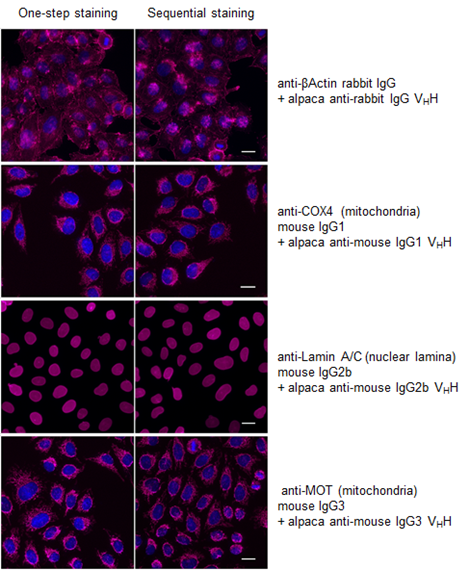What is one-step immunostaining?
This method reduces incubation time, hands-on time and the number of washing steps.
What is one-step immunostaining?
Why is using a Nano-Secondary beneficial for one-step immunostaining?
Why do I need a Nano-Secondary with high affinity and specificity?
Where can I find a one-step staining protocol?
Does one-step immunostaining work with conventional secondary IgG antibodies?
Does one-step staining also work in multiplexing applications?
Do Nano-Secondaries also work in a sequential staining approach?
What is a Nano-Secondary?
What is one-step immunostaining?
One-step immunostaining is the simultaneous incubation of primary and monovalent secondary antibody (fragment), i.e. a Nano-Secondary. This method reduces incubation time, hands-on time and the number of washing steps. One-step immunostaining can be used to probe one antigen or to detect several antigens in a multiplexing approach.
One-step staining requires:
- a monovalent secondary antibody to prevent the formation of clustered complexes,
- high specificity and affinity of the secondary antibody to its target IgG, and
- a small size secondary antibody to limit the size of the resulting primary:secondary complex for fast tissue penetration and access to the primary antibody’s epitope.
Nano-Secondaries meet the above requirements and are therefore ideal probes for one-step staining. The parallel incubation of primary antibody and Nano-Secondary supports multiplexing in immunofluorescence and Western blotting, live-cell immunostaining, and improves cell viability for flow cytometric analysis.
One-step immunostaining may be also called pre-incubation, pre-mixing, and parallel incubation of primary and secondary antibody. The performance of one-step immunostaining does obviously also depend on the performance of the used primary antibody: the primary antibody needs to bind specifically and strongly to it cognate target.
|
|
|
|
Simultaneous immunostaining, also called one-step immunostaining vs. sequential immunostaining. Nano-Secondaries stain different primary antibodies equally well in one-step staining and sequential staining. HeLa cells were immunostained with different primary antibodies and Nano-Secondaries Alexa Fluor® 647 (1:1,000, magenta). Cell nuclei were stained with DAPI (blue). Scale bar, 20 μm. |
Nano-Secondaries have a very high specificity; they are even subclass-specific and do not cross-react with IgGs from other commonly used species.
Why do I need a Nano-Secondary with high affinity and specificity?
A high affinity of the Nano-Secondary to its target IgG is important to ensure proper complex formation and facilitates detection of low abundant targets. Notably, the high specificity of the Nano-Secondary (which has been carefully determined and can be found in the product specification sections here) are needed when multiple primary antibodies are used for multiplexing. ChromoTek Nano-Secondaries have a very high specificity; they are even subclass-specific and do not cross-react with IgGs from other commonly used species.
Where can I find a one-step staining protocol?

In practical terms, one-step immunostaining is an all-in-one approach: the Nano-Secondary is pre-mixed with the primary antibody and the mixture is immediately added to the sample. Pre-incubation of the primary and Nano-Secondary before application to the sample is not required. For the incubation step, follow the instructions of the primary antibody’s protocol.
Does one-step immunostaining work with conventional secondary IgG antibodies?
Pre-mixing or co-incubation of primary and conventional secondary antibody is not recommended, because the bivalent antibodies can form large complexes. These large clusters of primary and secondary antibodies are bulky and aggravate target access and tissue penetration. Deposits of these precipitated antibodies can lead to unspecific signals and artefacts.
Does one-step staining also work in multiplexing applications?
Multicolor staining, also called multiplexing, allows the simultaneous analysis of multiple targets in the same sample. One-step staining is ideal for multiplexing since it’s possible to incubate several primaries and multiple Nano-Secondaries (conjugated to different dyes) at the same time in an all-in-one approach. Especially one-step multicolor staining enables to streamline the tedious staining process by reducing incubation times and number of wash steps.
It is recommended to use different species and/or subclass primary antibodies.
Do Nano-Secondaries also work in a sequential staining approach?
Of course, Nano-Secondaries can be used in a conventional sequential staining method or two-step approach. Here, the primary antibody is first applied to the sample, followed by a washing step and subsequent incubation with the Nano-Secondary. Note that sequential staining is recommended for multiplexing experiments of Nano-Secondaries in combination with conventional secondary antibodies.

Multiplexed immunostaining of HeLa cells with two alpaca anti-mouse Nano-Secondaries and one conventional secondary antibody. Green: mouse IgG3 anti-Lamin + alpaca anti-mouse IgG3 VHH Alexa Fluor® 488. Red: mouse IgG1 anti-Tubulin + alpaca anti-mouse gG1 VHH Alexa Fluor® 568. Magenta: rabbit anti-Ki67 + conventional polyclonal secondary anti-rabbit-AF647. Scale bar, 10 μm. Images were recorded at the Core Facility Bioimaging at the Biomedical Center, LMU Munich.
What is a Nano-Secondary?
Nano-Secondaries consist of alpaca Nanobodies/ VHHs that bind to primary antibodies with high affinity in a species and subclass specific manner. Nano-Secondaries are conjugated to Alexa Fluor® dyes. Currently, Nano-Secondaries that bind to rabbit IgG and subclass specific anti-mouse IgGs are available.

